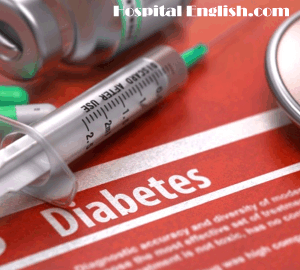Disease State Directors: these articles prepare students to explain about the disease itself and also be able to relay the important information that patients should know.
Diabetes: Type 2
Pre-Reading Vocabulary:
arteries
blurred
cells
condition
destruction
diabetes
failure
fatigue
function
glucose
hyperglycemia
hypertension
infection
injections
life expectancy
metabolic syndrome
nephrons
neuropathy
numbness
obesity
overweight
pancreas
resistant
retina
retinopathy
symptoms
therapy
ulcers

Listen to the 2 articles:
Listen and try to answer the discussion questions or take the quiz. You can also listen and read along with the scripts below.
Listen to the audio file and then you may advance to the discussion or comprehension questions. Listen as many times as you need to answer the questions. (You can read the full articles below.)
Listen to the audio files and then you may advance to the discussion or comprehension questions. Listen as many times as you need to answer the questions. (You can read the full articles below.)
Follow-ups:
- After completing the test exercises, try the speaking activity with the conversation questions.
- Roleplay a nurse/patient dialog where the nurse explains about the disease to a new diabetes patient.
For self study: Verify you understand the key words for the articles. Then try to answer the following conversation questions, speaking out loud.
Discussion Questions:
- What are the main features of type 2 diabetes?
- What are some ways to manage type 2 diabetes without medication?
- What are some of the complications associated with type 2 diabetes?
- What information is important to tell a new patient?
Reading Article 1: read the article and then answer the questions.
Article 1: Overview of Type 2 Diabetes ![]()
Type 2 diabetes is the most common of the two forms of diabetes, affecting 90% or greater of the people with diabetes. In type 2 diabetes, the pancreas produces insulin but the cells of the body become resistant or the amount of insulin produced is not enough. Glucose builds up in the blood stream (hyperglycemia,) and the cells of the body are unable to function properly.
Type 2 diabetes can affect anyone at any age but is more common in overweight populations, people with a family history of type 2 diabetes, the elderly, and people with metabolic syndrome (problems with hypertension and cholesterol issues.) The origin is still unknown but it is probably a combination of factors.
Many life-threatening problems can occur with uncontrolled blood glucose levels. The three most notable are retinopathy, kidney damage, and circulatory problems.
- Retinopathy is caused by damage to the small blood vessels of the retina. These blood vessels begin to leak fluid into the retina which leads to blurred vision.
- Kidney damage is cause by destruction of the small vessels in the nephrons allowing protein to flow into the urine. As this neuropathy continues, the function of the kidney declines and leads to kidney failure and end-stage kidney disease.
- Circulatory problems and nerve damage are cause by a hardening of the arteries. This causes loss of sensation, risk of ulcers, infection and can lead to amputation.
The effects of type 2 diabetes on the body are often irreversible and compounding. Quick diagnosis and immediate strict control of blood glucose levels is crucial.

Comprehension Questions:
1. What is the problem with insulin in type 2 diabetes?
2. What populations are most likely to get type 2 diabetes?
3. What causes retinopathy in diabetes patients?
4. What causes kidney damage in diabetes patients?
5. What causes the circulatory problems in diabetes patients?
Reading Article 2: read the patient information article and then answer the questions.
Article 2: Type 2 Diabetes Information for the Patient ![]()
Type 2 diabetes is caused by a lack of insulin or the body doesn't recognize the insulin, called insulin-resistance. Insulin moves nutrients into the cells of the body. When insulin resistance occurs, the cells of the body starve and many problems occur. The initial damage to the body can go unnoticed but the damage is severe. Uncontrolled blood sugar can lead to kidney failure, heart disease and even amputation.
Some common symptoms of uncontrolled blood sugar are frequent urination, increased thirst, dry mouth, vision problems, fatigue, and numbness in the hands and feet, among others.
Treatment of type 2 diabetes is usually managed with oral medication. There are medications that help increase insulin production and medications that increase the cells' sensitivity to insulin. Combination therapy may also be required. If oral therapy fails, insulin replacement therapy may be necessary. This uses insulin injections. Constant monitoring of blood sugar levels several times per day is very important. This can be done with blood sugar monitors.
Exercise, weight loss and diet management can be very effective means of managing type 2 diabetes initially. Obesity (the condition of being overweight) is a major factor in causing type 2 diabetes. In type 2 diabetes, exercise and weight loss can make dramatic changes for the better.
The damages and problems in the body caused by diabetes can often go unnoticed until they are serious. Proper management of blood sugar levels isn't easy, but aggressive therapy and control can greatly improve quality of life and lengthen life expectancy.
Comprehension Questions:
1. What happens when insulin resistance occurs?
2. What are the symptoms of high blood sugar?
3. How is type 2 diabetes treated?
4. What are some ways to initially treat diabetes without medication?
5. How can diabetes patients improve their quality of life and life expectancy?


End User License Agreement: You are free to download any resource from this site as an end user and MES-English.com grants you an End User License with the following restrictions: You may not redistribute, copy, modify, transfer, transmit, repackage, charge for or sell any of the materials from this site. You may use photocopies or printouts for distribution to your students. MES reserves the right to terminate or make changes to this agreement for any reason and without notice.
Copyright © 2006 - 2024 Hospital English | restrictions | privacy | about | contact
